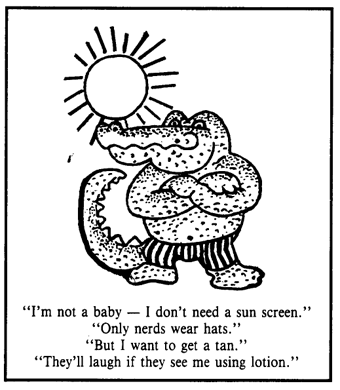
by Sharon Beder
Introduction
Human Skin Cancer
Sunscreen and Fabric
The Mouse Model of Cancer
Studies Using Skin Tissue
Drugs and Sunlight
Plant and Algae Growth
Conclusion
Glossary
Bibliography
The message that it is unhealthy to stay in the sun without protection is only slowly getting through to Australians. Research shows that although 97% of people in Australia are aware of the risks of skin cancer from sun exposure, many still aim to get a fashionable tan and will lie on the beaches with little or no sun protection for hours to achieve it. Australian beach culture is deeply entrenched and the image of the bronzed surfer with sun-bleached hair is a cultural icon.
In the mid-1980s campaigns to counter this nonchalant attitude towards skin cancer were launched all over Australia. The NSW Cancer Council has its “Slip, Slop, Slap’ Campaign - “Slip on a shirt, Slop on a Sunscreen and Slap on a Hat” - and more recently the NSW Health Department launched its “Me No Fry” campaign aimed at young people.

A character from the NSW Cancer Council campaign
The message seems to be filtering through at last. By 1990 there were reports that more people were using sunscreens with a 15+ sun protection factor (SPF) and fewer were using sunscreens with an SPF of 8 or less. Fashions are slowly changing too. Sun protection is becoming more acceptable to the fashion conscious and models used in fashion magazines seem to have lighter skin according to Dr Simon Chapman, senior lecturer in community medicine at the University of Sydney, who has studied mid-summer editions of fashion magazines such as Dolly, Cleo, Cosmopolitan, Vogue and Women’s Day. (SMH 1/10/91)
However there remains some scepticism about the threat posed by ozone depletion. When a German journalist recently questioned the Australian Olympic Committee, which is bidding for the Olympic games, suggesting that Sydney had an ozone depletion problem that could affect the health of athletes, he was greeted with ridicule by Australian officials. One was reported in the Sydney Morning Herald as saying “we have no problem with the ozone layer in Sydney. It is a mischievous piece of information which is moving about.” (27/7/92)

From a Pharmacy Self Care Health Facts (Pharmaceutical Society of Australia).
The Committee called in the experts to back them up. Dr Paul Lehmann, head of the ozone science unit of the Australian Bureau of Meteorology, was reported as saying that although there had indeed been a decrease in ozone over NSW and the other southern states of Australia, the subsequent increase in UVB radiation was “not a hazard.” Dr Paul Fraser, a senior CSIRO atmospheric scientist said that Berlin suffered a similar percentage depletion to Sydney. (SMH 20 & 21/7/92). Other less scientific spokespersons denied that Australian athletes, cricketers or tennis players suffered any ill effects from playing sport in Sydney.
Rather than use this as an opportunity for real public education about the dangers of sun exposure and the wisdom of protection and prevention, the desire to attract the Olympic games to Sydney meant any meaningful discussion about ozone depletion was suppressed in the game of one-upmanship with the Germans.
A couple of days later there was a report from Melbourne that a family had been awarded $100,000 as compensation for the death of a bricklayer at the age of 33 from a melanoma on this scalp. The case was said to be the first of its kind, but would not create a legal precedent because the compensation was the result of an out of court settlement. Nevertheless it was hailed, by the executive director of the Australian Cancer Society, Mr Lawrence Wright, as a landmark decision which would force every employer to consider providing protection for employees who have to work outside in the sun. (SMH, 24/7/92).
Whilst there is a basic understanding in the Australian community that too much sun can give you skin cancer, there is much that still needs to be understood. For example, it is not so well known that unless we change our habits the majority of Australians are likely to get skin cancers at sometime during their lifetimes and that a significant number will die from them. Few people know that some sunscreens do not protect against the effects of UV exposure on the immune system. Few people know that they can be exposed to UV radiation through their clothes. Many people think that if they get a tan then they are protected or that they should not apply a sunscreen till they have built up a tan. How many people know that they can get skin cancers from only exposing their arms and neck to the sun? How much sun is too much? There are many questions, which the wider community needs answers to, that scientists are beginning to be able to answer.